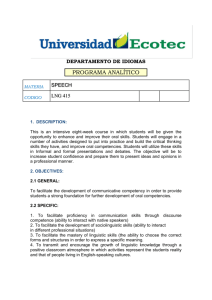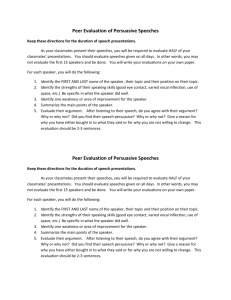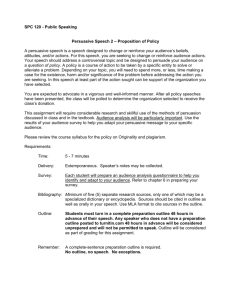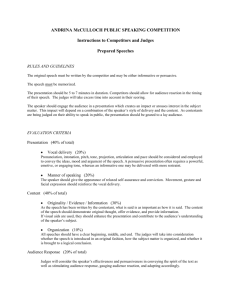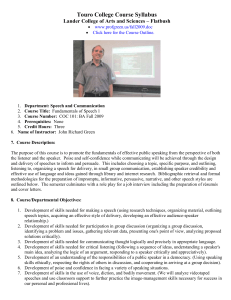SUPA Presentational Speaking Syllabus
advertisement
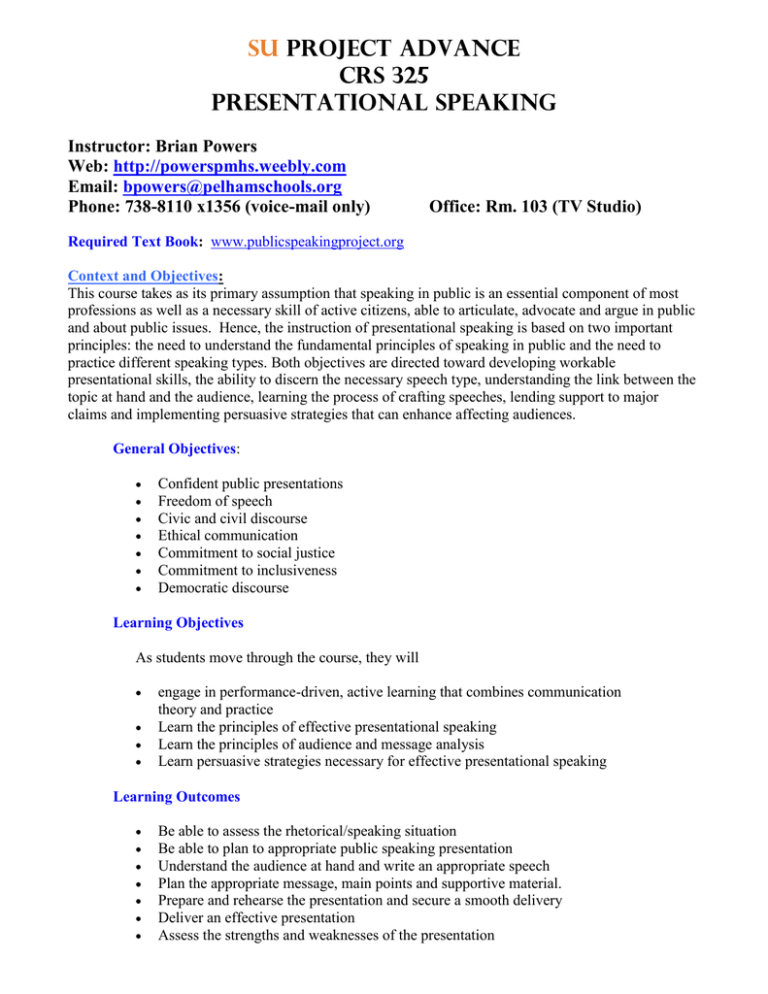
SU Project Advance CRS 325 Presentational Speaking Instructor: Brian Powers Web: http://powerspmhs.weebly.com Email: bpowers@pelhamschools.org Phone: 738-8110 x1356 (voice-mail only) Office: Rm. 103 (TV Studio) Required Text Book: www.publicspeakingproject.org Context and Objectives: This course takes as its primary assumption that speaking in public is an essential component of most professions as well as a necessary skill of active citizens, able to articulate, advocate and argue in public and about public issues. Hence, the instruction of presentational speaking is based on two important principles: the need to understand the fundamental principles of speaking in public and the need to practice different speaking types. Both objectives are directed toward developing workable presentational skills, the ability to discern the necessary speech type, understanding the link between the topic at hand and the audience, learning the process of crafting speeches, lending support to major claims and implementing persuasive strategies that can enhance affecting audiences. General Objectives: Confident public presentations Freedom of speech Civic and civil discourse Ethical communication Commitment to social justice Commitment to inclusiveness Democratic discourse Learning Objectives As students move through the course, they will engage in performance-driven, active learning that combines communication theory and practice Learn the principles of effective presentational speaking Learn the principles of audience and message analysis Learn persuasive strategies necessary for effective presentational speaking Learning Outcomes Be able to assess the rhetorical/speaking situation Be able to plan to appropriate public speaking presentation Understand the audience at hand and write an appropriate speech Plan the appropriate message, main points and supportive material. Prepare and rehearse the presentation and secure a smooth delivery Deliver an effective presentation Assess the strengths and weaknesses of the presentation Course perspective: This course is skill based but it is informed by a rich history of rhetorical theories development over many centuries. These theories are essential for understanding the practice of presentational speaking. The course is structured in such a way that the necessary foundations for public presentations are covered in the first few weeks of the course, allowing for a more focused presentation in the remaining two thirds of the term. Most of the reading is front loaded as most chapters are needed for a comprehensive view of the fundamentals of public presentation. Assignments: Introductory presentation (Graded but it carries no points) Informative presentation (100 pts) Persuasive presentation (150 pts) Persuasive Arguments Paper (150 pts) Impromptu presentation (50 pts) Argumentation presentation (150 pts) Attendance (100 pts) Participation (100 pts) Exam 1 (100 pts) Exam 2 (100 pts) Grading: 935 pts- 1,000 pts= A 900pts- 934 pts= A870pts- 899 pts- B+ 830pts- 869pts= B 800pts- 829pts= B770pts- 799pts= C+ 730pts- 769pts= C 700pts- 729pts= C650pts- 699pts= D 649pts and below= FAcademic Integrity: “Syracuse University sets high standards for academic integrity. Those standards are supported and enforced by your instructor, SU faculty and Project Advance administrators. The presumptive sanction for a first offense is course failure (SU grade of F), accompanied by the transcript notation “Violation of the Academic Integrity Policy.” Students should review the Office of Academic Integrity online resource “Twenty Questions and Answers About the Syracuse University Academic Integrity Policy” and confer with your instructor(s) about course-specific citation methods, permitted collaboration (if any), and rules for examinations. The Policy also governs the veracity of signatures on attendance sheets and other verification of participation in class activities. Additional guidance for students can be found in the Office of Academic Integrity resource: ‘What does academic integrity mean?’” Your high school may also impose additional penalties for any violations consist with your high school's policies. You should interpret this statement to also mean that you cannot “lift” words or portions of speeches delivered by others, without attribution. Related Links: The Academic Integrity Policy: http://academicintegrity.syr.edu/academic-integrity-policy/ Twenty Questions and Answers about the Academic Integrity Policy: http://academicintegrity.syr.edu/faculty-resources/ Academic integrity defined: http://academicintegrity.syr.edu/what-does-academic-integrity-mean/ Syllabus Statement for Turnitin This class can use Turnitin, a plagiarism prevention system. The ease of using the Internet has made it very easy for students to “cut and paste” material into papers that they are writing without proper citation. I will submit all/some/ papers that you write in this class to Turnitin, a service that identifies “matched text.” I will then interpret the originality report, based on your writing capability and writing style. In this class, you will also be given the opportunity to submit your own papers to Turnitin to check that all sources you have used are properly acknowledged and cited. Note that all submitted papers will be included as source documents in the Turnitin.com Descriptions of assignments 1. Introduction speech (not graded) – This initial speech allows you to get a feel for the publicness of presentation. This is your opportunity to sense what it feels like standing in front of an audience and make necessary adjustments for improved public presentations. Your task is to introduce yourself but you must go beyond basic biographical information. You can present specific information, special characteristics, or unique experience (3-4 minutes in length). 2. Informative speech (100 pts) – With this speech, you inform the audience of a procedure, person, event, act, a development, or a place of interest. Your task is to inform (but not persuade) your audience, in an organized, coherent structure (6-7 minutes in length). 3. Persuasive speech (150 pts) – With this speech your task is to persuade the audience to adopt a point of view, take an action, keep an action or point of view, or inoculate against future and counter persuasion. Get your topic approved by instructor before writing it. 6-8 minutes in length. With this and the next assignment, the instructors should engage the students in a critical analysis of several speeches (either students’ speeches or famous ones taken from other sources). 4. Argumentative Presentations (50 pts) – Following the persuasive speech, each student will deliver an argumentative presentation that can be construed as part of a debate. With this assignment, students must developed a clear stance and be completely aware of the argument(s) on the other side. (6-8 minutes in length). (This assignment could be considered part II of the previous Persuasive Speech). 5. Impromptu speech (50 pts) - You will be asked to speak on unexpected topics, for about four minutes and do so in an educated and organized manner. Your task is to be able to articulate a clear topic and do so without losing composure. The expectation here that you be competent in your presentational skills and that you provide an adequate presentation (5-6 minute in length). 6. Participation (100 pts) - to be determined by instructor, based on attentiveness and contributions to various class discussions. Also included under participation is student evaluations of others’ presentations (evaluations of classmates’ speeches are required from each student throughout the course) Exams (100 pts for each) - 2 exams each covering about half of the material read and discussed. Alternatives: The first four assignments are planned for creating the foundation of speaking in public. Modifications to the syllabus, however, are possible and even encouraged. The following ideas are possible: a. In place of the impromptu speech, instructor can develop a critical analysis unit, reading/viewing a famous speech; asking students to write a response paper to specific issues presented in the speech. b. Another possibility is to focus on a debate and ask students to present a position paper on one side of the issue, identifying claims and supportive material as well as the logic being used. c. Take advantage of specific local issues (in school or the community) to allow students to showcase their oral presentation skills, connecting the school to the community be it the public, businesses or the professional settings. Note: All presentations are based on bringing to the podium only an outline. A verbatim text of a given speech is not allowed. There is a pedagogical explanation that guides this requirement. Most effective speakers are effective because they do not read the speech but are familiar with the outline and thus can speak to the audience (as distinct of speaking at the audience with a manuscript speech). Only after becoming an effective speaker, can speakers take a complete speech text and yet maintain good eye contact with the audience as if following only an outline. Criteria for Evaluating Presentations Your grade for the course is determined primarily by your performance. The primary criteria for assessing the quality of your presentations include the content of your presentation, your research of the topic at hand, your word choice, delivery and organization. How are speeches graded? The following descriptions will help you understand the prerequisites for each grade. “A” Speaker: An “A” speaker is equipped with virtually all skills needed in affecting the oral transmission of ideas, feeling, beliefs, attitudes, values, and behaviors. The “A” speaker has packaged information—well selected information, appropriately supported ideas—adapted to the particular audience he or she is facing and to the proposition or central idea being advanced. The language in which that information and those ideas are phrased is clear and psychologically motivating but above all, appropriate to the audience, the speaker, the topic and proposition, and the occasion. The “A” speaker is making maximum movements, gestures, and facial expressions. In a sentence, an “A” speaker is illustrating the strengths of oral public communication. “B” Speaker: A “B” speaker is certainly better than average, yet normally has room for improvements in one or two important areas of oral public communication. Transitions may be missing, or, introductions and conclusions may be a bit flat; some ideas may be too general yet; or, an appropriate delivery skill may be present but lacks polish. A “B” speaker at least can develop clearly a proposition or central idea with enough information and support to give it impact. The “B” speaker, in other words, is showing definite signs of thinking and acting rhetorically, but has not yet achieved complete mastery of oral communication. “C” Speaker: A “C” speaker will get along, in all probability, facing day-to-day public communication situations [lectures, offering short presentations at work, etc.]. Ideas generally are there and well packaged; clarity has been achieved, although maximum impact probably has not. Unimaginative—i.e., non-engaging—introductions and conclusions may be employed; a “C” speaker probably either reads too much or attempts to memorize full sentences or paragraphs; he or she may not move much and possibly speaks with a deadpan face; distracting mannerisms may be present. A “C” speaker, in other words, has no debilitating defects as an oral communicator, yet has exhibited few outstanding skills either in assembling materials or in transmitting them. “D” Speaker: A “D” speaker has one or two major problems in public oral communication, problems which definitely will affect future success. “D” speeches often are developed poorly [either presented merely assertively or with no illustrations, metaphors, etc., to give them enough clarity and impact]. A “D” speaker may almost completely read an address, present an “essay” instead of a comparatively extemporaneous speech, shake so badly that an audience worries about the speaker instead of the speech, refuse to look a an audience steadily, ignore basic techniques of coherent transitions, appropriate introductions and conclusions, and the like, or fail to use the assignment time well by preparing something other than common place material. A “D” speaker either turns off or fails to engage the audience. “F” Speaker: It is almost impossible not to communicate something to an audience; it is almost impossible to earn an “F.” The failing grade is used in case of lying and plagiarizing, when assignment has been completely missed or on those rare occasions when a speaker completely falls on his or her face because of nervousness or ill-preparedness. Note: A grade lower than a “C” will not transfer as college credit. Class Schedule Week 1: Course Introduction Foundations: Providing an overview of the fundamentals of public speaking (speaker, speech topic, audience, setting and their interdependence). Read: Chapter 1. Viewing sample speeches. Week 2: Preparation: Planning, topic selection, research, and audience considerations. Read: Chapters 2-3. Viewing sample speeches. Week 3: Organization: identifying main points, organizing the presentation, building introduction and conclusion. Read: Chapters 4-5. Introduction speech Week 4: Development: Supporting material, reasoning, language and style, establishing credibility. Read: Chapters 6-7. Introduction speech Week 5: Speech type: motivational appeals, informative and persuasive presentations. Read: Chapters 8-9. Week 6: Presentation: Planning the presentation, practice, vocal and physical delivery, keeping composure. Read: Chapters 10, 11, 12. Week 7: Viewing sample speeches and preparing for the informative speech. Read: Chapters, 13, 14, 15. Week 8: Informative Presentations Read: Chapter 16. Week 9: Informative Presentations (continued) Week 10: Preparations for Persuasive Presentations View and analyze several persuasive speeches Exam # 1 Week 11: Persuasive Presentations (A likely schedule will include about 3-4 presentations per a 40 minutes session including initial feedback). Week 12: Persuasive Presentations (continued). Read Chapter 17. Week 13: Argumentative Presentations Week 14: Argumentative Presentations (continued) Week 15: Review, discussion and selected presentations of the argumentation papers. Speeches of special occasion: Preparations for the impromptu speeches Week 16: Impromptu Presentations Week 17: Impromptu Presentations (continued) Exam II Week 18: Course summary Note: the selection of chapters is a based on the onlinetext.

